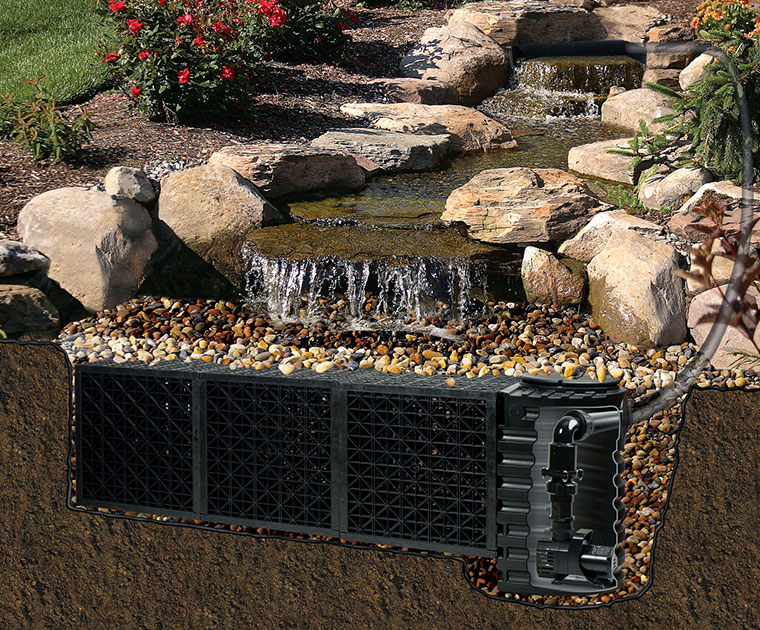Pond-Free 101 Chapter 4
The Development of Pond-Free Features
The first Pond-free features had simple reservoirs, holes in the ground with waterproof liners in them, backfilled with gravel to ground level. Gravel displaces two-thirds of the space in a lined excavation, leaving only one-third for water storage, but it’s a simple and sturdy way to make sure the reservoir neither collapses nor lets anyone fall in. Pumps were originally just buried in the gravel, but that made them difficult to service. The development of Pump Vaults, strong perforated chambers that could be buried in gravel without crushing, provided easy access to submerged pumps and easy way to locate automatic fill units to keep the water topped off.
Even enhanced by Vaults, gravel-filled reservoirs are limited by the fact that two-thirds of the hole is backfilled with heavy gravel, labor-intensive to transport and backfill. The reservoir needs to hold enough water on startup to fill up the stream or falls and start the feature recirculating without exposing the pump, so a reservoir two-thirds filled with gravel means you need to dig three times the hole to accommodate all that gravel and still have enough water storage. When you want a sizeable stream or falls, that becomes a pretty big hole! The next big advance in reservoirs addressed that drawback with equipment borrowed from stormwater storage technology. The Water Matrix, a reinforced cube or box that fills the space in the ground sturdily enough to support the weight of foot traffic or even vehicles, allows for a strong, structural reservoir that contains about 96% water, in huge contrast to gravel-filled reservoirs which hold only 33% water. Reservoirs using matrix blocks can be one-third the size and hold the same amount of water, or conversely, the same size hole will hold three times the volume of water as a comparable reservoir filled with gravel. The greater efficiency of these water matrix reservoirs, coupled with the savings in material and labor costs by eliminating the gravel backfill, has led to an explosion in the popularity of these systems.
Finally, the creation of the stream or waterfall has been vastly simplified by the use of waterfall spillways that connect directly to the pipe from the pump and provide an easy-to-hide, sturdy source for the waterfall that resists shifting and settling and keeps the water from leaking back down along the hose and outside the liner.

The first Pond-free features had simple reservoirs, holes in the ground with waterproof liners in them, backfilled with gravel to ground level. Gravel displaces two-thirds of the space in a lined excavation, leaving only one-third for water storage, but it’s a simple and sturdy way to make sure the reservoir neither collapses nor lets anyone fall in. Pumps were originally just buried in the gravel, but that made them difficult to service. The development of Pump Vaults, strong perforated chambers that could be buried in gravel without crushing, provided easy access to submerged pumps and easy way to locate automatic fill units to keep the water topped off.
Even enhanced by Vaults, gravel-filled reservoirs are limited by the fact that two-thirds of the hole is backfilled with heavy gravel, labor-intensive to transport and backfill. The reservoir needs to hold enough water on startup to fill up the stream or falls and start the feature recirculating without exposing the pump, so a reservoir two-thirds filled with gravel means you need to dig three times the hole to accommodate all that gravel and still have enough water storage. When you want a sizeable stream or falls, that becomes a pretty big hole! The next big advance in reservoirs addressed that drawback with equipment borrowed from stormwater storage technology. The Water Matrix, a reinforced cube or box that fills the space in the ground sturdily enough to support the weight of foot traffic or even vehicles, allows for a strong, structural reservoir that contains about 96% water, in huge contrast to gravel-filled reservoirs which hold only 33% water. Reservoirs using matrix blocks can be one-third the size and hold the same amount of water, or conversely, the same size hole will hold three times the volume of water as a comparable reservoir filled with gravel. The greater efficiency of these water matrix reservoirs, coupled with the savings in material and labor costs by eliminating the gravel backfill, has led to an explosion in the popularity of these systems.
Finally, the creation of the stream or waterfall has been vastly simplified by the use of waterfall spillways that connect directly to the pipe from the pump and provide an easy-to-hide, sturdy source for the waterfall that resists shifting and settling and keeps the water from leaking back down along the hose and outside the liner.





